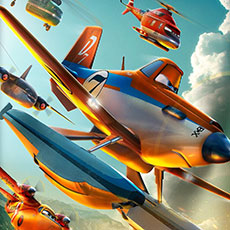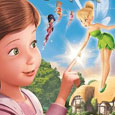Century 21/United Artists (1966, 1968), MGM Home Entertainment (July 20, 2004), 2 discs, 182 mins plus supplements, 2.35:1 anamorphic widescreen, DTS/Dolby Digital 5.1/Mono, Rated G, Retail: $29.98
Storyboard:
The Supermarionation rescue heroes star in two feature films. In the first film, International Rescue is asked to protect a rocket ship set to go to Mars. In the next film, the team must rescue a hijacked passenger vessel with Lady Penelope aboard.
The Sweatbox Review:
Thunderbirds was a huge success not only in the UK, but in much of the world after it premiered on television in 1965. Many consider Thunderbirds to be a high point of the Supermarionation shows, a group of series that used marionettes in action-adventure stories. The brilliance of these shows was in their use of advanced special effects and stunning miniatures, not to mention the spectacular music of Barry Gray. The driving force behind all of these series was executive producer Gerry Anderson, with increasing influence from his wife Sylvia.
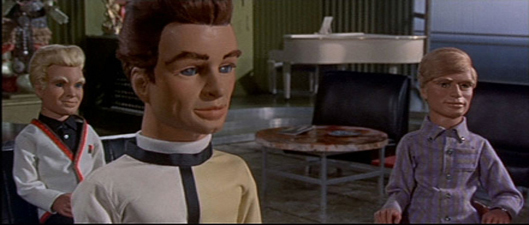
What set Thunderbirds apart was its engaging premise and hour-long format. The series featured the adventures of International Rescue, whose purpose was to aid people in impossible peril. The team was made up of retired millionaire astronaut Jeff Tracy and his five sons, as well as a cultured London agent named Lady Penelope. Each of the sons commanded an amazing vehicle— a Thunderbird, ranging from a space satellite to an undersea ship. Although the 60-minute runtime sometimes resulted in padded episodes, it did give the chance for the stories to breathe, allowing for more character development as well as plot twists. The plotlines became more sophisticated, and the characters had to overcome more obstacles. Sometimes they would even fail and have to try again. This added an air of realism to a show whose actors were literally wooden. Like the earlier Supermarionation shows, the special effects and music topped it all off, resulting in surprisingly exciting and entertaining television.
With Thunderbirds a smash hit, Anderson approached ITC chairman Lew Grade about making a theatrical feature. United Artists, it turned out, was interested in distributing such a film, and Grade authorized a budget of 250,000 pounds. The new movie would be shot alongside the last six episodes of the television series, with filming commencing in March of 1966 and lasting six months. Gerry was the uncredited executive producer, and Sylvia produced. The puppets were spruced up in order for them to stand up to big-screen scrutiny. The facial features became smoother, the painting was more detailed, and the clothes had more texture. The regular crew and voice cast was all present for the big-screen effort (Jeremy Wilkin had taken the place of David Holliday’s distinctive voice for Virgil Tracy by this time). Thunderbirds Are Go had a fabulous premiere, but then the movie proceeded to tank at the box office. It seemed that audiences were not sure that they would see anything truly new that they had not already seen on television. (Unfortunately, the Andersons’ marriage was performing similarly at this time, making the publicity tour quite uncomfortable for them. Their marriage still continued for a time, however, thanks partially to an unexpected pregnancy they discovered in early 1967.)
Nevertheless, United Artists was undaunted, determined as they were to have another successful moneymaking franchise that could sit alongside James Bond. They asked for another film, and the budget was upped to 300,000 pounds. In May of 1967, part of the way through shooting of Captain Scarlet And The Mysterons, Anderson’s company began four months’ shooting of Thunderbird 6. This led to an interesting quandary, since recent advancements had allowed for the Captain Scarlet puppets to be much more realistically proportioned than the Thunderbirds ones had ever been. A decision was made to split the difference, so that the Thunderbird 6 versions would not have the bigger heads of the TV versions, but were also not perfectly proportioned either. The film was completed in January 1968, but its premiere was delayed until that July. It didn’t really matter, as this second feature was also doomed to disappointing box office returns. The dream of an ongoing Thunderbirds movie franchise was over. Fortunately, the two movies that were made are still around to enjoy for audiences old and new.
Timed to coincide with Universal’s release of the new live-action Thunderbirds film, MGM (long since merged with United Artists) released a two-DVD set that includes both of the puppet movies as well as plentiful bonus features that should thrill fans.

Thunderbirds Are Go (1:33:06)
The main titles include one for “TV Century 21 Cinema Productions” and the familiar Thunderbirds theme. The first scene features the assembly of a modular spacecraft, the Zero X, set to a rousing score. Inside, The Hood (notorious bad guy) is taking pictures. His presence there leads to an accident, and the ship crashes spectacularly as The Hood makes his escape, but not before losing some blood (one of the few instances of blood being shown in Thunderbirds). Two years later, a committee convenes to examine a report about the crash and to discuss whether to plan another launch for Mars. One person votes against the idea, simply because the security issues have not been dealt with yet. He proposes that International Rescue be called in.
This is a bit of a conundrum, since IR isn’t normally in the security business, making it a weak plot point. Jeff Tracy, head of International Rescue, is also confused, and it takes him a long time to decide whether to grant assistance. By this time, we are twenty minutes into the film, and it is the first we have seen of the Tracy family (aside from the titles). We are then treated to new launch footage of the Thunderbird crafts, since they had to be re-done in widescreen footage. The Thunderbirds will indeed guard the launch, and it is a good thing too, as The Hood is there again!
Later, youngest brother Alan is feeling disappointed that he was not able to share in the celebratory evening after the mission, leading to a dream sequence involving real-life singers Cliff Richard and the Shadows. I do not normally care for dream sequences (as I have noted time and time again in my reviews), and this one falls into the common problem of not really advancing the plot; however, it is at least rather creative and nicely shot, and it certainly does showcase Alan and his feelings about his place on the team. I also noticed that brother Gordon was pouty about his lack of participation as well, but there is little follow-up on this until he has a chance to help in the end.
The problem with the dream sequence is that at this point the movie seems to stop. The mission appears to be over, after all, even though we are just halfway into the movie. The audience really needed to be given a hint, at this time, about just what the movie was going to be about for the second half. Instead, we are given a dream sequence while the plot is put on hold. The story then advances six weeks, as the Zero X lands on Mars. There, they encounter a wonderful menace in a terrific monster- and special effects-filled sequence. It is a great scene, but does not involve our heroes in the least, making it seem out of step with the rest of the movie. We then skip another six weeks ahead to when the Zero X returns to Earth and runs into trouble requiring a rescue. And it is an exciting rescue, too, among the best that the Thunderbirds have ever pulled off.
It is just too bad that the pacing on the film is so off. If it seems like I have revealed too much, it is only because this film seems like three or four different movies. Another pass at the script could have tightened things up considerably and kept the story moving forward. What we have instead is a collection of great scenes which work better individually than as a whole. Still, there is much excitement and spectacular special effects to enjoy, which is what attracts most people to Thunderbirds anyways. I may have criticized the pacing, but I still enjoyed the movie quite a bit.
Fans may note that Brains (the inventor of the ships and their hardware) is barely in the movie, Tintin has little to do, and her father Kyrano’s only scene was cut.

Thunderbird 6 (1:29:13)
The second feature is much stronger as a film, even though it uses a lighter tone and is more lackadaisical about getting to the action. A conscious effort was made by writer Sylvia Anderson and director David Lane to eschew the hardware-driven quality of the first film and to focus more on the characters while imbuing the script with some lighter touches.
Some of the characters short-changed in the first film get plenty of screen time this time around, and we also get to see a familiar face much earlier than in the previous film. Brains is in the first scene, where he presents his idea for an airship to the New World Aircraft Corporation. The next scene gives some general Thunderbirds background that was largely missing from the first film, too, as Jeff Tracy discusses the five existing Thunderbirds vehicles with Brains and announces the need for a “Thunderbird 6”.
Meanwhile, the new airship is ready for its maiden voyage, but Brains has to miss it in order to design the new Thunderbird craft. Alan and Tintin use an old World War I biplane to fly to Lady Penelope, while Scott and Virgil prepare to guard the launch. (Hmmm, sounds like the first film.) Meanwhile, the crew is killed by nefarious fellows who take their place on the automated ship. Their aim seems to be to eventually capture Thunderbirds 1 and 2, as well as Brains.
The airship takes off with Penelope, Alan, and Tintin unknowingly in the clutches of the killers. The rest of the movie allows this situation to further develop naturally, leading to a harrowing rescue in the third act. The plot is certainly simpler than the first film, but it flows more naturally and follows the usual three-act film structure much more expertly. The result is a more satisfying viewing experience in one sense, although we have to wait until the final act for most of the action. When it comes, though, look out— because at this point the movie combusts amid gunfire, narrow escapes, and massive explosions. The biplane figures prominently (and actually somewhat logically), in stark contrast to Thunderbirds’ usual high-tech emphasis.
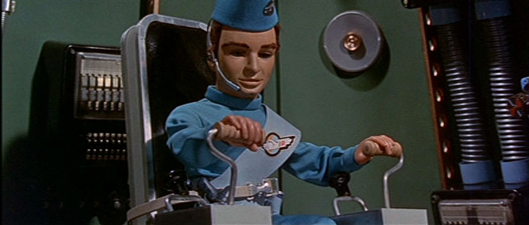
Is This Thing Loaded?
Perhaps due to the fact that these movies were already released on DVD in Region 2 (where Thunderbirds has a much stronger fan-base) with some extras in 2001, Region 1 viewers now have the opportunity to enjoy a great set of bonus features. Region 2, by the way, is now getting the same two-disc set as well. The Main Menus are nicely done, combining some animation with scenes from the films. The Main Menu for the first movie spotlights the five Tracy boys, while the one for the second movie highlights Thunderbirds 1 through 5 and their pilots. The other menus are static, illustrated with shots of the other characters.
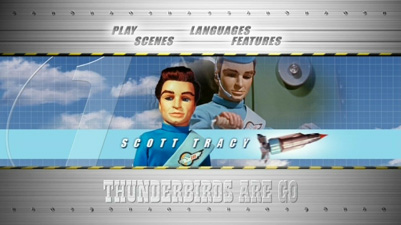
Thunderbirds Are Go
An Audio Commentary by producer and writer Sylvia Anderson and director David Lane starts things off wonderfully. The two are well versed with their subject, and are able to offer many insights and bits of trivia. Among other things, they discuss the Techniscope process, Barry Gray’s music, pacing (they note that today’s films are generally faster-paced, but acknowledge that the movie is too slow in spots), influences on puppet design (Sean Connery and Lorne Greene figure prominently), Stanley Kubrick and the 2001 connection, the puppet wires, using a Rolls Royce, and what the heck F.A.B. means.
There are then three Featurettes which are really all parts of the same one, and can be played consecutively. They feature Sylvia Anderson, David Lane, film historian Richard Hollis, and puppet coordinator Mary Turner. History And Appeal (10:25) looks at the origins of Thunderbirds, revealing it was inspired by a real-life mining accident and was influenced by the TV show Bonanza. It then goes into the films, explaining that Gerry Anderson was quite busy with the TV shows he was producing, and Sylvia was given more responsibility for the movies. Factory Of Dolls And Rockets (8:39) goes into the workings of the puppets, from painting the wires to using solenoids to achieve lip synchronization. This featurette also inadvertently gives the impression that the term “Supermarionation” was invented for the films, although it actually began with the second set of Supercar episodes. It also briefly discusses how a video camera within the film camera allowed for video feed to go out to the puppeteers and the director and technicians. This technique, now known as “video assist”, has become very common in filmmaking but was used for the first time on Thunderbirds Are Go. Epics In Miniature (7:48) examines some of the technical aspects of filming the movies, including a demonstration of the Techniscope process, a discussion of making puppets for the big screen, the wizardry of special effects man Derek Meddings, and Barry Gray’s seventy-piece orchestra.
Who Said That? is a quick, easy quiz where you match up audio clips with the Tracy brothers who said them. The reward is a 30-second clip of Sylvia talking about the term “F.A.B.”. Animated Photo Gallery (3:22) is a montage of movie stills and behind-the-scenes shots. Polishing off this first disc is the rather beat-up Theatrical Trailer (1:25), and assorted DVD trailers for MGM special editions as well as MGM titles in general.
Incidentally, Chris Bentley’s book The Complete Gerry Anderson: The Authorised Episode Guide lists some deleted scenes from Thunderbirds Are Go, as the original cut went over fifteen minutes longer than what was asked by the distributor. Too bad these could not be placed onto the DVD.
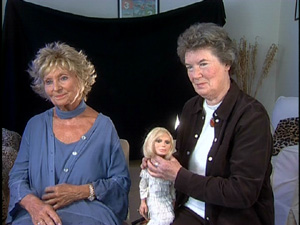
Thunderbird 6
First, there is another Audio Commentary by Sylvia Anderson and David Lane, just as informative and interesting as the first one. This one touches on the disappointing grosses for the movies, thoughts on portraying violence and romance in Thunderbirds, ethnic stereotypes, merchandising, and philosophies about doing “children’s” shows. There are barely any gaps in these commentaries, and it is well worth listening to them.
The Featurettes are just a continuation of the ones on the previous disc, and all the featurettes have clips from both films. Play them all together, and you will have nearly an hour-long documentary about the two movies. Lady Penelope (9:49), naturally, focuses on the female agent and her appeal. Building Better Puppets (8:09) looks at making and manipulating the puppets, as well as talking about the appearance by Cliff and the Shadows in Thunderbirds Are Go. Tiger Moth (6:19) does discuss the biplane seen in Thunderbird 6 (such as matching the live action and miniature shots, which is marvelous by the way), but Hollis and Lane also discusses the difference between the two films in general, and the famous story of how the production was at one point under arrest (due to an airplane stunt) is told.
Craft Mission Match Up Quiz requires you to match the vehicles with their pilots, with a reward of another 28-second clip of Sylvia Anderson, this time talking about a Peter Cook/Dudley Moore Thunderbirds sketch. Another Animated Photo Gallery (2:57) is next, followed by the Theatrical Trailer (1:57) and the same MGM promotional material that was on the first disc.
The notable exclusion here is certainly the lack of participation from Gerry Anderson. With all due respect to the many contributions of Sylvia, Gerry is still considered the father of Thunderbirds and his absence on this DVD set is unfortunate. One certainly wonders if it has something to do with his long-time divorce from Sylvia, who obviously has a major presence on these DVDs (and justifiably so).
Case Study:
MGM made this one up special, producing a special collectible package that many fans should appreciate, while others may roll their eyes. Essentially, the two discs each get their own keepcase, with a cardboard slipcase, making it seem very much like A & E’s Thunderbirds TV show collections. Closer examination, however, shows that the slipcase is rather shiny, and embossed as well. Also, the specifications sheet on the back falls off to reveal a foldout piece that has cutouts of various vehicles from the movies. Additionally, there is a sheet of punch-out magnets inside the box, featuring Thunderbirds characters and vehicles. Now, you too can create a Thunderbirds diorama right on your own fridge at home! I don’t think I will do that personally, but it’s fun to know that I could!
Ink And Paint:
The digital remastering done for these movies rivals the work done on the fabulous DVD sets for the TV show. Almost nowhere will you see a speck of dust, as the picture remains free of practically any physical artifacts. On the whole, the compression work is first-rate, with edge enhancement and pixellation being non-issues. If the picture seems a bit soft, it is due to the age of the material, as well as the process used to film the movies. In order to achieve the 2.35:1 aspect ratio, the producers had to make a compromise. They were unable to use anamorphic lenses, because anamorphic lenses had insufficient depth of field, and were unusable for special effects shots. This prevented the use of most of the various “scope” processes from being used. Instead, the films were shot in “Techniscope”, which used one-half of a 35mm film (two perforations long), effectively giving an overall resolution similar to 16mm film.

The first feature’s video quality is the weaker of the two, due mainly to two factors. It has an excess of grain and loss of detail in the Thunderbirds launch sequence about a third into the film. This may be due to the original film elements, as the footage appears the same way when used in the featurettes. There is also an ugly vertical squiggly line on both ends of a scene transition at the thirty-minute mark, right near the middle of the screen. Additionally, the framing is a little cramped on the sides for this film, as the titles and any other full-width text gets cut off on the edges. In contrast, the second film’s video is practically flawless.
Scratch Tracks:
Amazingly, MGM is able to offer both movies in remastered Dolby Digital AND DTS 5.1 tracks, as well as the original mono track (in two channels). Considering that these films are almost forty years old, the results are thrilling. This is not a “faux 5.1” remaster, as both the Dolby Digital and DTS tracks contain fine separation effects and a fair bit of thunder, although they do fulfill expectations in failing to enter into the very lowest of audio frequencies. Overall, though, the audio is much fuller and more dynamic than one would expect. The edge goes to the DTS tracks, which are just that much more crisp and forceful. With all the rolling explosions and fly-bys in these films, there is much to enjoy with these audio remasterings. Kudos should be given to MGM, too, for including the original mono tracks for the purists.

There are English, French, and Spanish subtitles.
Final Cut:
Devotees of Thunderbirds will enjoy these fun and exciting movies, which are basically extensions of the TV show. It is quite cool to watch these marionettes in widescreen adventures, and it is actually nice that the two movies have such different yet viable tones to them. MGM has done an admirable job with the video and audio, there is a wealth of documentary material, and special effort was made to give a fun package to the fans. All this, and it is very reasonably priced, too! Even if you are new to the Thunderbirds phenomenon, these movies are a great place to start. Highly recommended!
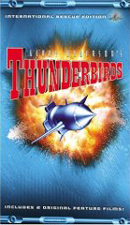 | ||
 |







